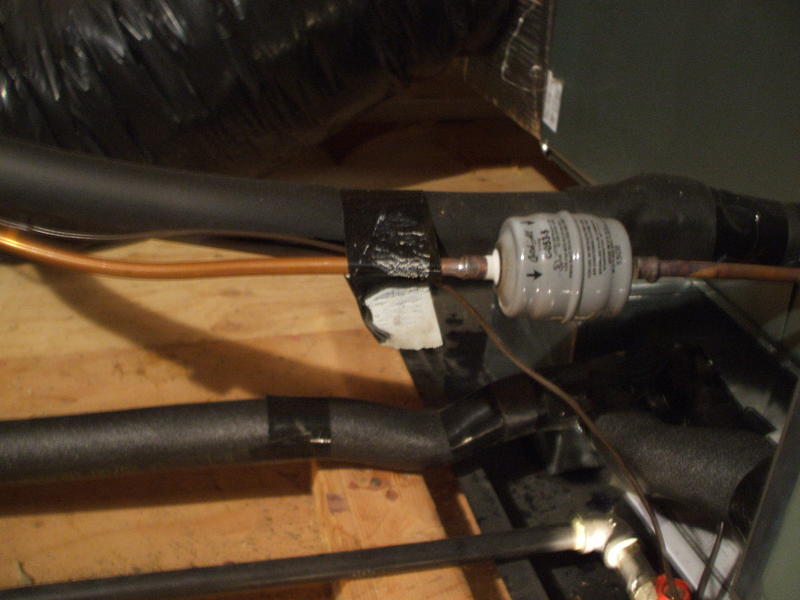I inspected a 2 year old house that just got sold. The HVAC unit is RUUD Achiever 90 Plus - High efficiency. I looked at the manual online it says it has a trap in the unit for the furnace side. the condensation line for the AC connects to the furnace condensation line. Is the trap good. Plus it looks like it is taking combution air from the attic
Your picture and comments left me with more questions than answers. I’m not familiar with that manufacturer but most new high effeciency furnaces vent directly outside and bring in outside air for combustion. Also I’m not sure why you would need a trap in a condensation line that should drain out by gravity. The picture you show with a device in line would appear to me to be a control valve of some sort so as the fluid travels only one way. I admit I don’t know and would like to see some post that are more knowledgeable.
High efficiency furnaces require a trap for the condensation line to prevent products of combustion from entering the living space. Most furnaces are supplied with a factory made trap.
The trap for the air conditioner is required because it is on the negative pressure side of the furnace and will not drain properly without a trap here.
From the picture if that is the only trap, the furnace blower will draw in products of combustion from the condensate line of the furnace.
The one way device Tim mentioned is a liqid line filter/drier and the arrow indicates refigerant flow for proper installation.
Some hi eff furnaces may be optionally installed as a one pipe system. It may seem logical in this installation as the combustion air is being drawn from the attic but best performance is always achieved with a two pipe system where the furnace draws its combustion air from the exterior of the building.
I’ve installed Ruud equipment. The condensate trap for the AC needs to be trapped seperately. there should be a vinyl tube that came with the furnace for the combustion trap that would be tied in to the drain line AFTER the AC trap. The comb air intake should be from fresh air.
The attic IS outdoors.
Look up what a trap is for. They are not installed on anything but non-pressurized lines, are they?
That is a liquid line filter-dryer. It does not control flow. It is only intended for flow in one direction. It is for refrigerant, not condensate.
I don’t think so!
Products of combustion should never come in contact with anything inside the house or air handler. Look up heat exchanger.
No it’s not! Furnaces are upstream of the evaporator coil. You don’t blow cold air across a heat exchanger.
This unit has an internal drain and no it does not need to be installed after the condensate trap.
Ben G, where are you and your HVAC course? :shock:
I’ll bite my lip now…
The attic is NOT “outdoors”, but is equivalent to being “outdoors” as it regards combustion air under certain circumstances.
Attic ventilation openings shall not be subject to snow or ice blockage and shall not have less than 30" vertical clear height at its maximum point. Attic ventilation openings shall be sufficient to provide the required volumes of combustion air AND…in addition…to provide adequate ventilation per IRC tables.
Your right Dave a/c coils are upstream of the blower on a gas furnace my mistake misinterpeting the picture and the given facts.
A hi eff furn WITHOUT a trap either factory installed or otherwise can allow products of combustion into the home however small through the condensate drain line, that was my point. The drain and exhaust are not part of the heat exchanger.
As far as an internal drain goes, the condensate still needs to be removed and I assume that is what Scott was suggesting with his comment to tap into the a/c condensate line after the trap because it seems to be the only condensate line going to a drain.
And thank you for your valuable non condensending input, it is much appreciated.
The unit comes in it’s packaging a trap kit to be installed by the installer. It is installed inside the unit but still must be connected to a drain line. If you install it before the AC trap you’ve double trapped. Or you need to run a seperate drain line for each.
Thanks for the clarification. My education never stops. Tim
Thanks for the clarification. My educatiion continues. Tim
I think my Ruud 90’s have a problem distributing flu condensate fumes around the house. They were installed with a 3/4" PVC trap right out of the condenser box and then connected to combustion condensate drain line and ran to outside drain. The big problem I can see is the trap will dry out quickly during heating season and blow hot air right down my drain lines. I think they might trap properly in the summer season but then the condensate is probably quickly flushed down the line.
If I understand you correctly the trap on a 90% furnace would not dry out in the heat mode due to the condensate being generated in the heating cycle on that type of furnace


